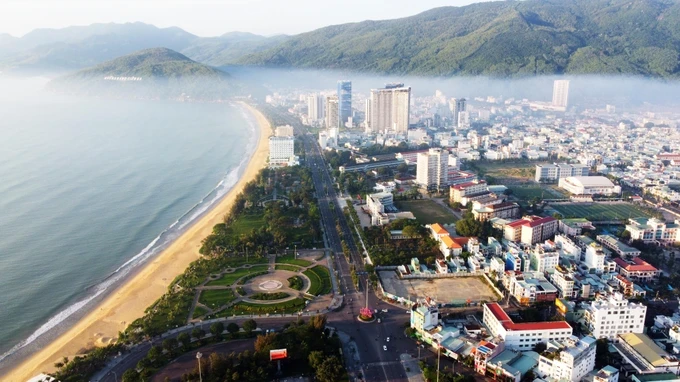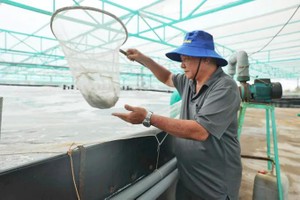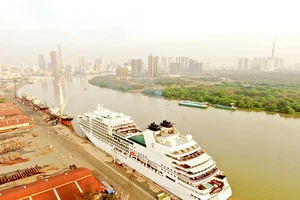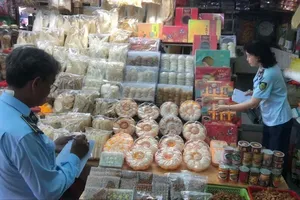
Twenty years ago, along the coast from Da Nang City to Hoi An City (in Quang Nam Province), there used to be small desolate fishing villages full of poor residents. With a strong aim to escape this poverty, generations after generations of state leaders in these localities have joined force to improve a connected route for better marine economy for the region.
The first fruitful result was the introduction of a ‘5-star’ coastal road linking Son Tra District of Da Nang City to Cua Dai estuary in Quang Nam Province in 2007. Along this road are charming tourist resorts and hotels as well as luxurious golf courses.
Encouraged by that success, Quang Nam Province continued to pour over VND7.1 trillion (US$279 million) into building Cua Dai Bridge and a coastal route linking Hoi An City – Tam Ky City and Chu Lai Airport. Finished in 2016, this most-wanted route offers more access to famous tourist cities of Da Nang, Hoi An, and Ky Ha Port as well. It is going to be connected to the Dung Quat – Sa Huynh route in Quang Ngai Province.
A similar story can be found in Quy Nhon City in Binh Dinh Province, whose traffic system used to be troublesome to use as the city is surrounded by the sea, mountains, and lagoons.
The first route to make a breakthrough in linking this city to neighboring areas is the 33—kilometer one towards Song Cau Town – the capital of aquaculture in the Central region in Phu Yen Province, which was completed in 2001. After that was a bloom of several international-standard tourist resorts.

In 2013, Rencontres du Vietnam – a scientific organization founded by Prof. Tran Thanh Van – selected Quy Hoa Town as its base. Since then, a lot of important international scientific conferences have been held year by year, welcoming thousands of global scientists from 40 countries to come and exchange experience, including 20 Nobel winners.
Not long after that, Binh Dinh was proposed to invest in another work in memorial of Uncle Ho and his father Nguyen Sinh Sac, who had been assigned as the Governor of Binh Khe District in the province. Uncle Ho was brought by his father to this place to learn French in Quy Nhon French – Vietnam School. Binh Dinh Province decided to build a square to commemorate this historical event.
Quy Nhon City has undergone many scientific planning activities to form a series of coastal roads, most of which have large space for public parks and community squares. Particularly, in 2002, the province constructed a 7-kilometer bridge linking Phuong Mai Peninsular – Bac Ha Thanh downstream. This cost-effective work has contributed to the sustainable development of coastal villages in the peninsula.
Moving north to Nghe An Province, the coastal communes of Quynh Lap (Hoang Mai Town), Quynh Bang, Quynh Luong, Quynh Minh (Quynh Luu District), Dien Hai, Dien Trung, Dien Van (Dien Chau District), Nghi Yen (Nghi Loc District) used to be underdeveloped places despite being sited near National Highway No.1A merely because of access limits.
In 2022, Nghe An Province decided to invest in a route with a length of 64.47km from Nghi Son to Cua Lo, using a capital of VND4.65 trillion ($182.7 million). The plan was wholeheartedly backed up by local residents as it is supposed to help improve the marine economy here as well as reinforcing the national defense in the Nghe An – Ha Tinh region.

Following the footstep of Nghe An Province are other province of Quang Binh, Quang Tri, Thua Thien-Hue, Quang Nam, Quang Ngai, Binh Dinh, Phu Yen, and Khanh Hoa. They have started numerous traffic infrastructure projects to form a long link of coastal roads worth thousands of billions of VND for economic growth.
For instance, the 100-kilometer route from Dung Quat to Sa Huynh ancient cultural area connects Dung Quat Industrial Park in Binh Son District of Quang Ngai Province to Hoai Nhon Town in Binh Dinh Province - the capital of aquaculture in the Central region.
Director Luu Nhat Phong of the Traffic Project Management Board of Binh Dinh Province informed that taking advantage of the financial support from the central Government, his province has added in the provincial budget and the ODA capital to have around VND7 trillion ($275 million ) to complete six important coastal road construction projects. The province has actively taken care of land clearance tasks for these projects, showing its strong determination and calling upon the aid of higher level authorities.
According to the Department of Planning and Investment of Binh Dinh Province, to mobilize resources for the growth of coastal infrastructure, right at the beginning, the province has identified public investment as an important resource to attract more capital from other sources. Therefore, it has boldly boosted the development of coastal roads as core routes while also paying attention to the East – West connection with three major routes, worth an investment of VND3.8 trillion ($149 million).
Similarly, Phu Yen Province is now focusing on completing its coastal route of 132.5km, becoming its core traffic line to better exploit the advantages of coastal areas in the provinces and to link to neighboring regions of Binh Dinh Province, Khanh Hoa Province, and the Central Highlands for economic and tourism activities.
























